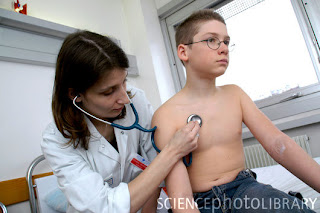Respiratory Examination

In medicine, the respiratory examination is performed as part of a physical examination, or when a patient presents with a respiratory problem (dyspnea (shortness of breath), cough, chest pain) or a history that suggests a pathology of the lungs.
Position/Lighting/Draping
Position - patient should sit upright on the examination table. The patient's hands should remain at their sides. When the back is examined the patient is usually asked to move their arms forward (hug themself position) so that the scapulae are not in the way of examining the upper lung fields. as many physicians around world request.
Lighting - adjusted so that it is ideal. Draping - the chest should be fully exposed. Exposure time should be minimized.
The basic steps of the examination can be remembered with the mnemonic PIPPA :
Reference : wikipedia

In medicine, the respiratory examination is performed as part of a physical examination, or when a patient presents with a respiratory problem (dyspnea (shortness of breath), cough, chest pain) or a history that suggests a pathology of the lungs.
Position/Lighting/Draping
Position - patient should sit upright on the examination table. The patient's hands should remain at their sides. When the back is examined the patient is usually asked to move their arms forward (hug themself position) so that the scapulae are not in the way of examining the upper lung fields. as many physicians around world request.
Lighting - adjusted so that it is ideal. Draping - the chest should be fully exposed. Exposure time should be minimized.
The basic steps of the examination can be remembered with the mnemonic PIPPA :
- Position
- Inspection (for example, "normal effort")
- Palpation (for example, "no tenderness to palpation", "fremitus WNL")
- Percussion (for example, "clear to percussion bilaterally" or "CTP B")
- Auscultation (for example, "clear to auscultation bilaterally" or "CTA B"; "no R/R/W" or "no rhonchi, rales or wheezes")
Reference : wikipedia
Labels:
Vital Signs,
Vital Signs - Respiratory


0 Komentar untuk "Vital Signs - Respiratory"